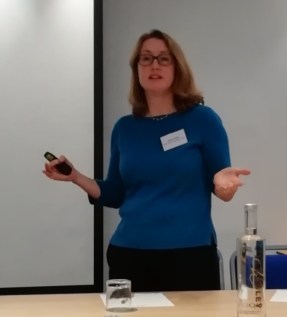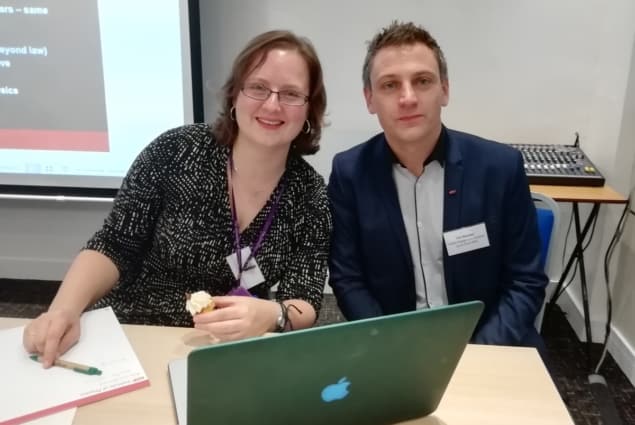Gender equality – how does medical physics shape up?
21 Nov 2018 Tami Freeman
How does the medical physics profession perform when it comes to gender equality? (Courtesy: iStock/grifare)
Physics has one of the largest gender gaps among all science, technology, engineering and mathematics (STEM) subjects; but within medical physics, the percentage of women is around 40%. So what is medical physics getting right, where could it improve further, and how could these factors be exploited to improve gender equality throughout physics as a whole?
These questions were the subject of a recent event organized by the Institute of Physics’ Medical Physics Group and Women in Physics Group. The meeting, Towards gender equality in physics – what is medical physics getting right?, began with presentations looking at history and current status of women working as medical physicists. Francis Duck.
Francis Duck.
 Francis Duck.
Francis Duck.The first speaker, Francis Duck from the University of Bath, took a look at how physics was first introduced into medicine at the turn of the nineteenth century and how, in parallel, women began training in medicine for the first time.
The use of electricity for medical treatments (diathermy) began in the mid-1890s, Duck explained, with UV therapy and radiography also being introduced. “In my view, 1895 was really the start of modern medical physics,” he said. And around that time, medicine became the first high-level profession to accept women.
During World War I, the wide use of medical technologies created a need for scientific expertise to support medical staff, providing opportunities for women to take posts previously reserved for men. Indeed, at this time, women often ran X-ray departments single handed. And in 1929, the Marie Curie Hospital opened for radiological treatment of women, with cervical cancer one of the first tumours to be successfully treated with radium. Such treatments required careful dosimetry, and women physicists took up this role.
Here and now
So how have things progressed since? Penny Gowland, from the Sir Peter Mansfield Imaging Centre, explained that at the University of Nottingham, half of undergraduates studying medical physics are female – in stark contrast to just 20% studying physics. So what’s driving that choice? Perhaps women are pressured by society into more “caring” jobs, she suggested. But more importantly, underrepresented groups tend to focus on careers with well-defined pathways. Penny Gowland.
Penny Gowland.
 Penny Gowland.
Penny Gowland.Gowland pointed out that medical physics is the only applied physics degree in existence and proposed bringing back degrees in applied physics. Demonstrating the real-world applications of all areas of physics could encourage more women to enter the field.
Further down the line, Gowland emphasized the need for good working practices in academia, with part-time and flexible working welcomed. She also noted that within medical physics, women tend to concentrate in applied rather than pure subject areas. “I think it is to do with confidence, which can be lacking in underrepresented groups,” she said. “Women need to be more confident.”
Ursula Johnson from University College London Hospitals, told attendees about working as a radiotherapy physicist within the UK’s National Health Service (NHS). She explained that her career choice stemmed in part from a school trip to a hospital’s radiotherapy unit, which demonstrated how physics learnt at school could be relevant to the real world.

Ursula Johnson.
Johnson pointed out that roughly 75% of NHS employees are women and, as such, “we don’t feel unusual, we are the majority”. While the gender balance may differ across medical physics sub-groups, in radiotherapy, it’s very much 50:50. “The NHS has a well-defined entry route, clear goals to achieve and a clear career structure — this may be quite appealing to women,” she said.
NHS policies promote equality and diversity, and support working flexible and part-time working. But how practical is this for medical physicists supporting clinical services? “Radiotherapy physicists need to be physically available, a lot of work is hands-on and being present is still necessary,” Johnson explained.
Johnson noted that at higher levels, women haven’t yet achieved equality, representing just 20% of heads of department in radiotherapy. She suggested that the barrier for women is not prejudice but rather confidence in putting themselves forward for promotion. In addition, readiness for a senior role often comes at a time when many women have increased family responsibilities, while part-time flexible working may be harder to achieve at higher job grades.
Industry options
The final speaker, Giulia Thompson from Elekta, provided the industry perspective. Her route into medical physics, she explained, began in her final year at school when a teacher’s explanation of the photoelectric effect inspired a shift in focus from humanities to physics. Following a PhD, in 2000 she joined radiotherapy technology provider Elekta, where she is now head of physics and research within the UK global engineering department. Giulia Thompson.
Giulia Thompson.
 Giulia Thompson.
Giulia Thompson.“The fact that my school made pupils study physics [to a high level] made a massive difference,” Thompson told the group. “My high-school physics teacher was female, and she was a good teacher. That was another contributing factor.”
Thompson’s transition into industry was in part prompted by a need to make a positive impact on people’s lives, she said, noting that this also motivates many of her male colleagues. She emphasized the importance of believing it’s not selfish to be successful and explained that women are sometimes less happy to speak out. “If you have something to say, feel confident that you can say it,” she said.
Thompson noted that Elekta has around 30% female employees globally, with four of nine members of its board of directors now women. She described how companies can help by supporting events such as the AAPM Women Physicists Luncheon, or engaging with schools and universities via talks, prizes or visits. At Lancaster University, for example, Elekta awards a prize for the best female engineering student.
Collective thoughts
Later in the day, attendees split into groups to discuss what medical physics is getting right – and what it is still getting wrong. The groups highlighted many positives, including several related to working in the NHS, which offers a clear career pathway, a variety of roles and a standardized recruitment process that protects against bias. Heather Williams and Phil Marsden organized and chaired the meeting.
Heather Williams and Phil Marsden organized and chaired the meeting.
 Heather Williams and Phil Marsden organized and chaired the meeting.
Heather Williams and Phil Marsden organized and chaired the meeting.Elsewhere, the prevalence of women working in medical physics — in hospitals, industry and academia — provides a wide range of role models to encourage others to apply. The multi-disciplinary nature of the job, with team working playing a key part, is another positive aspect. Meanwhile, the inclusion of medical physics within the UK’s A Level syllabus should encourage future interest.
As for where medical physics “could do better”, one example is that fewer women take part in large research projects, which are essential for career progression. This may be due to part-time workers being allocated more of the routine clinical work, leaving less time for research. Another issue disproportionally affecting women is returning to a medical physics role after a career break.
Other challenges highlighted by the groups included tackling presenteeism, introducing double-blind peer review to mitigate gender bias, and improving clarity of entry requirements for jobs within industry and academia.
Take-home points
The meeting concluded with another lively group conversation looking at how some of these issues could be tackled, starting with promotion of careers in medical physics. While bodies such as IOP, IPEM and the NHS produce many excellent resources, these need to be publicized and employed more. There’s also a current emphasis on university outreach, while it may be more productive to target schools and emphasize applied physics in careers information. The meeting attendees discuss how to improve access and progression in medical physics for women. (Courtesy: Heather Williams)
The meeting attendees discuss how to improve access and progression in medical physics for women. (Courtesy: Heather Williams)
 The meeting attendees discuss how to improve access and progression in medical physics for women. (Courtesy: Heather Williams)
The meeting attendees discuss how to improve access and progression in medical physics for women. (Courtesy: Heather Williams)For those working as medical physicists, career development is an important concern. Here, there’s a need for mentors to instil the confidence to apply for promotion. More time and support for training is key, as is the need to challenge managers’ expectations regarding part-time and flexible working — emphasizing that it’s a worker’s output, not hours, that count. In a similar vein, increased opportunities for job sharing could enable more part-time workers to move into senior roles.
Importantly, the field needs an alternative means to achieve qualifications such as the Higher Specialist Scientist Training (HSST) course. This 5-year programme requires study at a centre away from the usual workplace, which can place it beyond the reach of those with family responsibilities and prevent their progression to higher levels.
Another essential is an official scheme for medical physicists returning to work after a career break. While a returners scheme does exist, it is not well-publicized and may not be suitable for those who have been away for longer than five years. Such a programme should enable workers to easily retain or regain clinical registration, and will help maintain the profession’s existing skill base. And for those who choose to return part-time, it’s important that their role is scaled appropriately and includes developmental areas such as research and outreach.
Finally, the attendees considered how to boost connections and transitions between academia, industry and hospitals. It can be difficult, for example, for NHS staff to apply successfully for a role outside of the NHS if they are unfamiliar with the environment they hope to move into. Some type of network across the three areas, or perhaps the use of exchange programmes, could help overcome practical and psychological barriers in moving between them. This may be an area in which the professional bodies could provide help.
The field of medical physics is getting a lot right, and as the day’s activities proved, there’s no lack of enthusiasm, ideas and willingness to improve things even further.

Tami Freeman is an online editor for Physics World
from physicsworld.com 12/12/2022

Δεν υπάρχουν σχόλια:
Δημοσίευση σχολίου